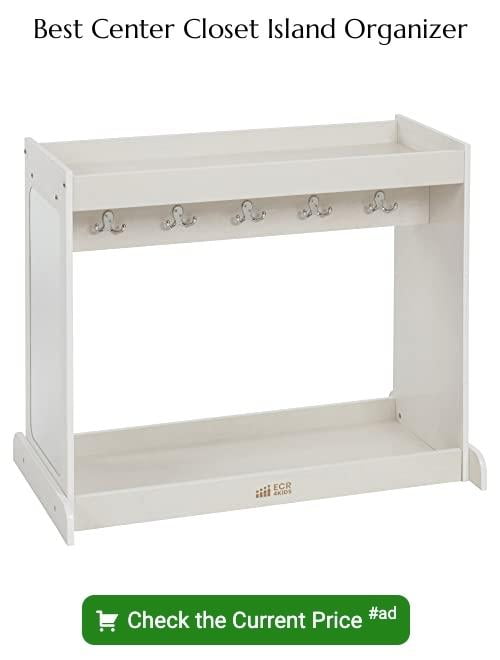Last updated on
Discover how a center closet island can revolutionize your storage solutions because it provides more space, enhances organization, and adds an element of luxury to your closet.
Key takeaways:
- A center closet island provides more space and enhances organization.
- It adds a touch of luxury and increases the resale value of your home.
- Measure your closet space to determine the appropriate size for the island.
- Design the island based on your storage needs, convenience, and ergonomics.
- Maximize the utility of your island with strategic drawer inserts and shoe shelves.
Benefits of Adding a Center Closet Island
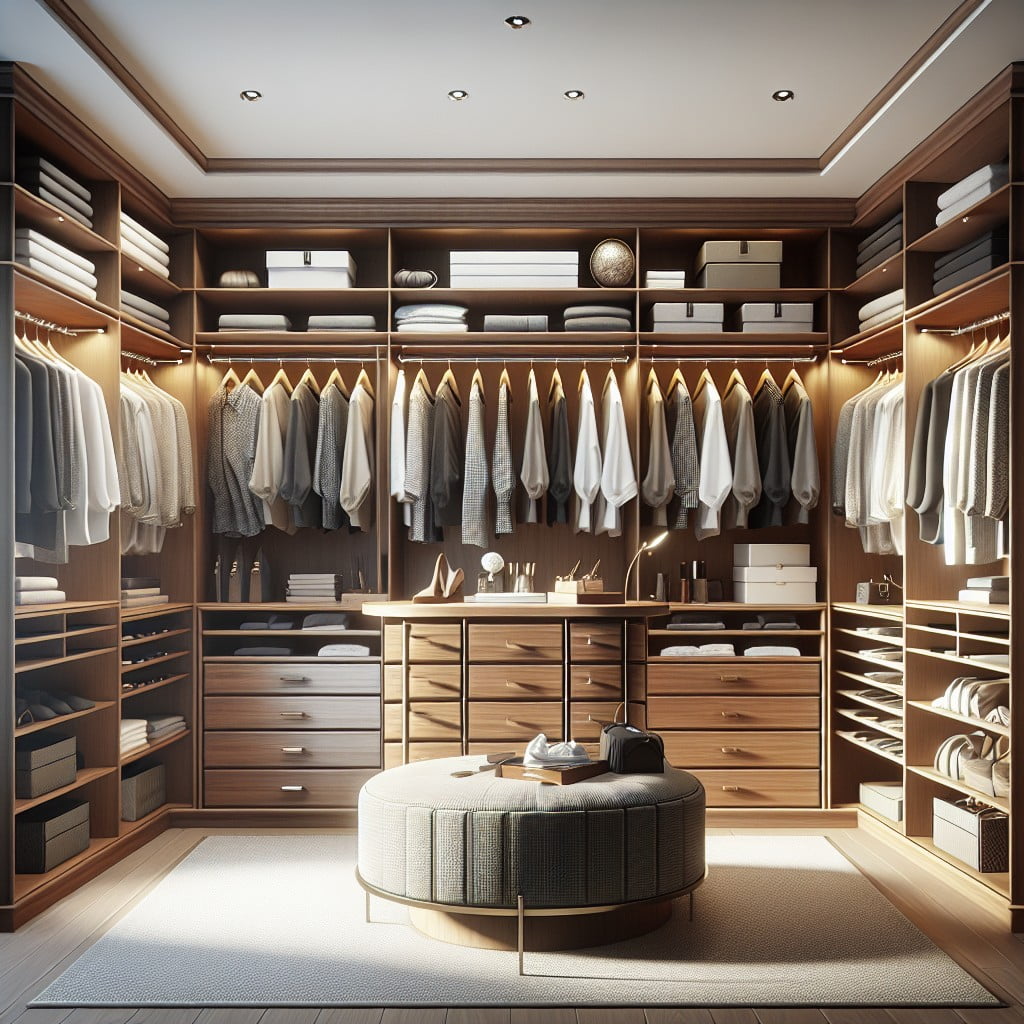
A center closet island elevates your storage capacity, allowing for additional drawers and shelves to keep items neatly organized. It serves as a dedicated space for folding clothes right out of the dryer, reducing the clutter that often accumulates on the bedroom floor.
For fashion enthusiasts, the island offers a convenient surface for planning outfits and accessorizing, with all essentials at arm’s reach. It also provides an opportunity to showcase statement pieces such as luxury handbags or jewelry in a central, visible location.
Beyond practicality, an island can significantly increase the resale value of your home by adding a touch of luxury to your walk-in closet, making it an investment that marries form with function.
Determining Appropriate Size for Your Closet Island
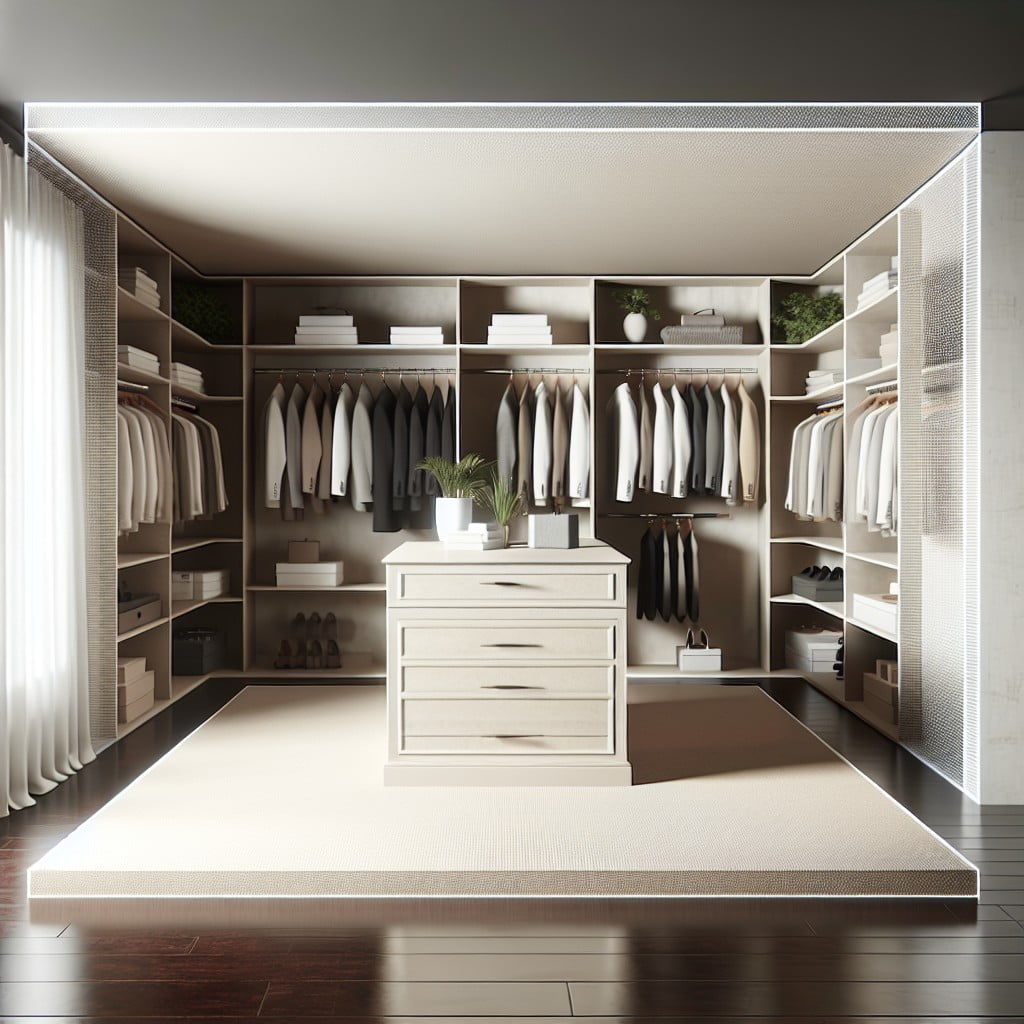
Measuring the closet space is the first step to ensure the island fits comfortably without hindering movement. Aim for a walking aisle of at least 36 inches around the island for easy access and a more open feel. This allows for a functional flow throughout the closet.
Take into account the existing or planned storage systems. If hanging clothes will be adjacent to the island, ensure doors and drawers can open fully without interference. The purpose of the island dictates its size; if it’s for folding clothes, a depth of 24 inches will suffice. For larger items or additional features like a benchtop, a larger footprint may be necessary.
Consider the room’s proportions. An overly large island can overwhelm a space, while a small one may look out of place. Match the island’s scale to the room to maintain visual harmony. An adjustable tape layout on the floor can help visualize the island’s size before committing to a design.
Designing a Functional Center Closet Island
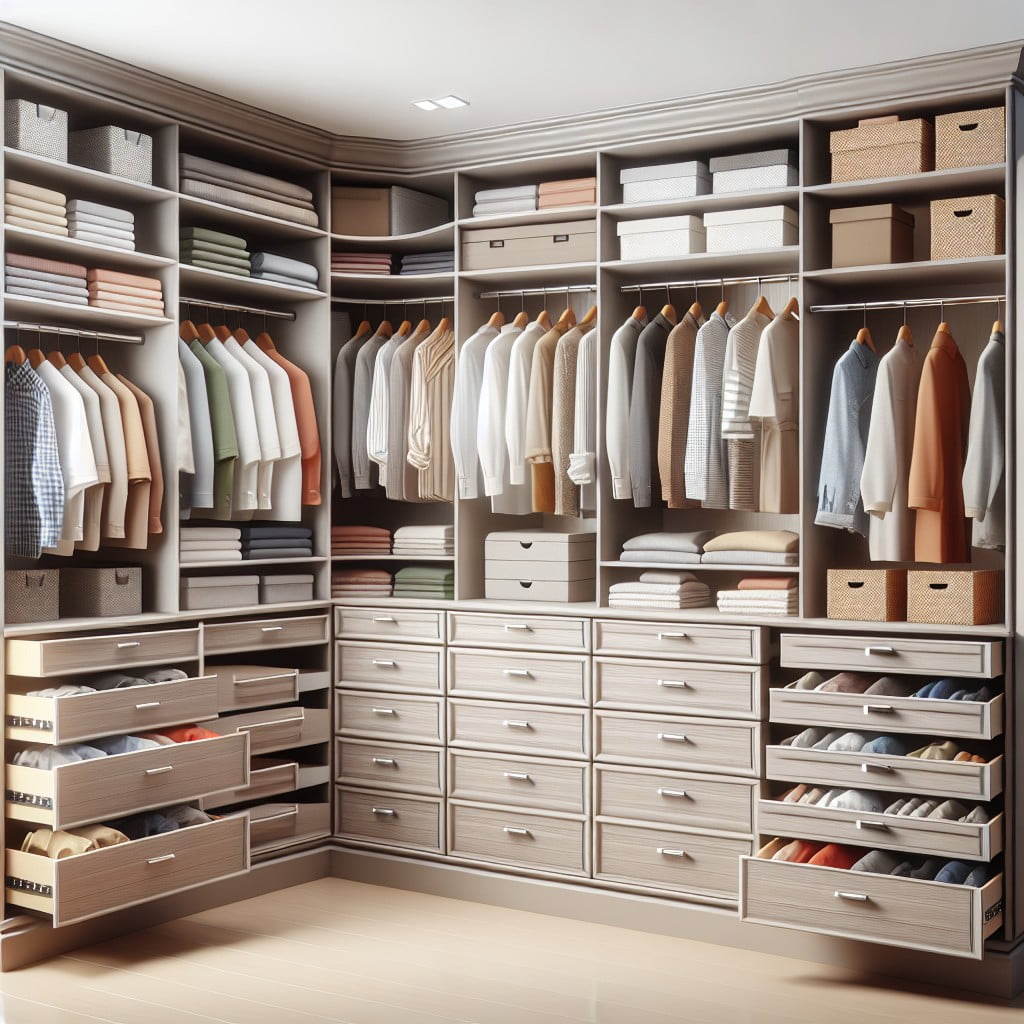
When planning the design of a center closet island, consider these key points:
- Assess your storage needs by categorizing items you plan to store, such as jewelry, accessories, folded clothing, or purses.
- Incorporate a variety of drawers, shelves, and open spaces to accommodate different types of items. Shallow drawers work well for jewelry, while deeper ones are suited for bulkier clothing.
- Think about convenience. Features like a built-in laundry hamper or retractable surfaces for packing and unpacking can enhance functionality.
- Factor in ergonomics. Ensure counter height is appropriate for your stature to prevent strain during use.
- Opt for smooth-gliding drawer slides and high-quality hardware for ease of access and durability.
- Leave enough aisle space around the island for comfortable movement within the closet.
Steps to Construct an IKEA Hack: DIY Closet Island
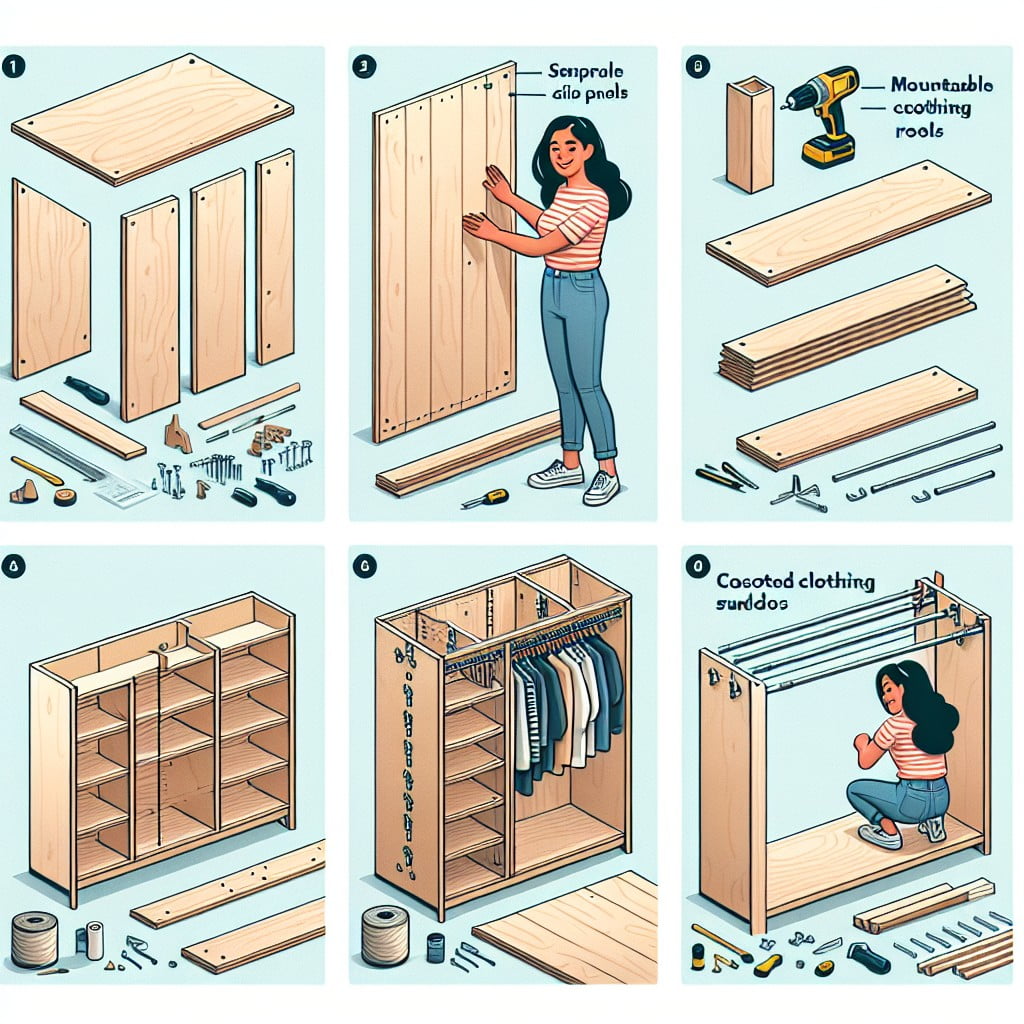
Select a suitable IKEA dresser or shelving unit as your base; ensure its dimensions fit your closet space. The Kallax or Malm series are popular choices due to their simplicity and storage capacity.
Assemble the IKEA unit following the provided instructions, but leave out drawer pulls or knobs until after the customization is complete.
Reinforce the structure, if necessary, by adding brackets or additional screws, to ensure it can withstand the weight of items you plan to store.
Elevate the unit off the floor with legs or a base to achieve the desired height and provide toe kick space; this also helps integrate the island into the closet design seamlessly.
Customize the look by painting or staining the unit to match your closet’s style and color scheme.
Add hardware such as drawer pulls, knobs, or handles that complement your closet’s design for a finished look.
Install drawer inserts, dividers, or trays to organize jewelry, accessories, and small items effectively.
For a polished finish, top the island with a countertop material such as wood or stone, cut to size, and secure it onto the base unit.
Remember to protect the floor and your work area while making any modifications, and always prioritize safety when using tools or handling heavy materials.
Optimizing Closet Island Storage With Drawer Inserts
Maximizing the utility of your closet island’s drawers hinges on strategic use of drawer inserts. These simple additions create designated spots for small items, preventing the all-too-common drawer disarray:
- Jewelry organizers: Velvet-lined inserts protect and separate necklaces, rings, and bracelets, making selection a breeze.
- Dividers for ties and belts: Keep accessories neatly aligned and easy to access.
- Compartmentalized trays: Ideal for sorting sunglasses, watches, and other fashion staples.
- Customizable layouts: Adjustable inserts allow for personalization based on your wardrobe needs.
Incorporating these elements not only maintains order but also saves time and extends the life of your belongings by minimizing wear and tear.
Showcasing Shoes With Shelves and Racks
Incorporating shelving into your closet island transforms it into a dedicated display for your footwear, making selection a breeze for every occasion.
Slanted shelves with heel stops highlight your shoes while preventing them from sliding off.
Consider adjustable racks to accommodate various shoe heights, ensuring boots and sandals coexist harmoniously.
For those with a penchant for high-end heels or designer sneakers, glass shelves serve a dual purpose: they showcase your prized pairs and make cleaning effortless.
Meanwhile, pull-out racks offer a hidden yet accessible approach, cleverly maximizing space without sacrificing style.
Additionally, integrate lighting into the shelving to accentuate your collection and facilitate easy color matching.
Soft, ambient lighting not only showcases your shoes but also adds a touch of luxury to your daily routine.
Remember, the right organization can turn your footwear into a focal point, marrying form and function in your closet design.
Choosing Drawer Fronts and Toe Kicks for Aesthetics
Selecting the right drawer fronts transforms the visual appeal of your center closet island. Consider both the finish and the style:
- Finish: Matte, gloss, or wood grain finishes can either complement or contrast with the overall design of your room.
- Style: Sleek, handle-less fronts offer a modern look, while classic paneled fronts suit a traditional aesthetic.
- Color: Neutral colors tend to blend seamlessly, whereas bold hues can make a statement piece.
Toe kicks are essential to protect cabinetry and contribute to the cohesive appearance. They should match or accentuate the drawer fronts. Remember to take into account the height for adequate foot clearance. Options include:
- Material: Wood or metal toe kicks can be chosen to match or contrast with the flooring or the island’s finish.
- Height: The standard is about 4 inches, giving enough room to prevent scuffing the island with your shoes.
By aligning the looks of drawer fronts and toe kicks with the closet’s design, the center island will not only be functional but also elevate the aesthetic of your space.
Enhancing Visibility With Elegant Closet Lighting
Good lighting goes beyond functionality; it transforms the ambiance of your space. Consider incorporating LED strip lights underneath shelves to provide a gentle wash of light over your items, making colors pop and textures stand out.
For a more dramatic effect, spotlights can highlight key areas and create a boutique feel. Pendant lights centered above the island impart a focal point and also serve as a decorative element.
Choose lighting with a high color rendering index (CRI) to see the true hues of your clothing and accessories—this makes matching outfits easier. Dimmer switches give you control over the mood and intensity; soft lighting can evoke a serene atmosphere, while brighter lights invigorate the space for morning routines.
Lastly, ensure all lights are cool to touch and energy-efficient to save on electricity bills and protect delicate items from heat damage.
Selecting a Countertop for Your Center Closet Island
When choosing a countertop for your closet island, prioritize durability and style. Materials like quartz, granite, or high-quality laminates offer longevity and can complement the existing decor. Quartz, in particular, resists stains and scratches, ensuring your workspace remains pristine over time.
For those seeking a warm, natural ambiance, a wooden butcher block is a viable option. It requires more maintenance but adds a touch of earthiness to the space.
Consider the countertop thickness as it contributes to the overall visual impact. Thinner slabs create a sleek, modern feel, while thicker tops tend to look more substantial and luxurious.
Remember to factor in the ease of cleaning when selecting your surface. Smooth, non-porous materials like quartz or polished granite reduce cleaning time, an essential feature for maintaining an organized and hygienic space.
Lastly, be mindful of color and pattern. While a bold countertop can be a statement piece, neutral tones often offer greater flexibility, adapting seamlessly to various closet color schemes and decor changes over time.
Maintaining a Clutter-Free Closet Island
Creating an organizational routine is crucial to keep the surface of your closet island clear and ready for daily use. Dedicate a few minutes each day to return items to their rightful places after use.
Utilize drawer organizers to categorize accessories, ensuring everything has a designated spot which discourages pile-up. Incorporate a small tray for frequently used items like watches or jewelry to ensure they don’t get scattered.
Adopt the habit of a regular decluttering schedule, perhaps seasonally, to avoid accumulation of unnecessary items. Lastly, treat the top of your island as a display area for a select few cherished items to maintain an elegant look and discourage clutter.
FAQ
What is the island in the middle of the closet?
A closet island is a standalone piece of furniture, located centrally in a closet, which contains countertop space, drawers, cabinets, or open shelving to conveniently store clothes and accessories.
What do you call an island in your closet?
An island in a closet is referred to as a closet island, providing additional countertop space and storage options for clothing and accessories.
What size is a closet center island?
A closet center island is typically a minimum size of 20 inches by 30 inches.
How big does a closet have to be for an island?
For a double-sided island with hanging storage on all side walls, a minimum room size of 12 x 13 feet is required.
What are the benefits of having an island in your closet?
An island in your closet maximizes storage, provides additional organizational options, and enhances ease of access to your items.
How can you efficiently utilize a center closet island for storage?
Efficient utilization of a center closet island for storage involves the systematic organization of items, dividing them into categories such as clothing, accessories, and shoes, and making use of drawers, shelves, and compartments to save space.
What are some design considerations when installing an island in your closet?
When installing an island in your closet, ensure to maintain enough circulation space, incorporate ample storage options, match the island’s design with your overall closet aesthetic, and choose appropriate and durable materials.
Recap:
